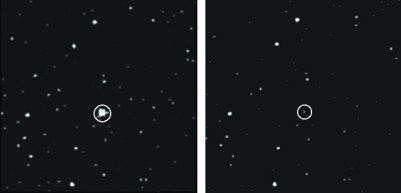Click here for this article in other languages
What Are Variable Stars?
 Variable stars are stars that change brightness. The brightness changes of these stars can range from a thousandth of a magnitude to as much as twenty magnitudes over periods of a fraction of a second to years, depending on the type of variable star. Over 1,000,000 variable stars are known and catalogued, and many thousands more are suspected to be variable.
Variable stars are stars that change brightness. The brightness changes of these stars can range from a thousandth of a magnitude to as much as twenty magnitudes over periods of a fraction of a second to years, depending on the type of variable star. Over 1,000,000 variable stars are known and catalogued, and many thousands more are suspected to be variable.
There are a number of reasons why variable stars change their brightness. Pulsating variables, for example, swell and shrink due to internal forces. An eclipsing binary will dim when it is eclipsed by a faint companion, and then brighten when the occulting star moves out of the way. Some variable stars are actually extremely close pairs of stars, exchanging mass as one star strips the atmosphere from the other.
The different causes of light variation in variable stars provide the impetus for classifying the stars into different categories. Variable stars are classified as either intrinsic, wherein variability is caused by physical changes such as pulsation or eruption in the star or stellar system, or extrinsic, wherein variability is caused by the eclipse of one star by another, the transit of an extrasolar planet (exoplanet), or by the effects of stellar rotation.
Why Observe Variable Stars?
The science of variable star astronomy teaches us about one important part of the universe -- the stars. Stars are the primary engines of cosmic evolution, particularly in the creation of elements heavier than hydrogen and helium which make up us and the world that we live in. Further, stars and their systems of planets are the only likely places we will find life in the universe; by studying stars (including our own Sun), we are also learning about possible abodes for life. Research on variable stars is important because it provides information about stellar properties, such as mass, radius, luminosity, temperature, internal and external structure, composition, and evolution. Some of this information would be difficult or impossible to obtain any other way. In many cases, it is the nature of the variability that provides the clues to the answers. This information can then be used to understand other stars.
Variable stars need to be systematically observed over decades in order to determine their long-time behavior. Professional astronomers have neither the available time nor the unlimited telescope access needed to gather data on the brightness changes of thousands of variable stars. Thus, it is amateur astronomers utilizing visual, photographic, photoelectric, CCD/CMOS, and DSLR techniques who are making a real and highly useful contribution to science by observing variable stars and submitting their observations to the AAVSO International Database. These important data are needed to analyze variable star behavior, to schedule satellite observations of certain stars, to correlate data from satellite and ground-based observations, and to make computerized theoretical models of variable stars possible.
Large surveys like TESS (Transiting Exoplanet Survey Satellite), which are searching for stars besides our Sun that might have planets of their own, have found thousands of stars that change in brightness. Each of these stars needs to be observed and studied to determine if the brightness is changing because of the star - the star is in fact a variable - or because of the presence of exoplanets orbiting it. Stars that may have exoplanets then need additional observations to determine information about it. Amateur astronomers using CCD/CMOS or DSLR techniques to make careful, high-precision observations are following up on many of the hundreds of these stars, and are submitting their exoplanet transit observations to the AAVSO Exoplanet Database. These observations are an important and valuable resource for researchers working in this new and important area of astronomy.
Spectroscopic observations of variable stars also provide valuable data for research. Amateur astronomers make a valuable contribution to science by observing with spectroscopy - recording the chemical makeup of a star at a given time - to obtain a spectrum of a variable star and submitting it to the AAVSO Spectroscopic Database.
Variable stars play a crucial role in our understanding of the universe. Cepheid variables have played a major part in determining distances to far-away galaxies and determining the age of the Universe. Mira variables give us a glimpse into the future evolution of our own star, the Sun. Accretion disks in cataclysmic variables help us to understand larger scale disk behavior, such as the activity inside active galaxies with supermassive black holes. Supernovae have led us to the surprising realization that the expansion of the Universe is accelerating. Even the search for extra-terrestrial life is illuminated by variable stars. Transiting extrasolar planets provide clues into the processes of planetary formation, and the very stuff life as we know it is made of comes from the hearts of stars that explode in the final stages of their evolution.
This article has been translated into other languages by volunteers:
- Azerbaijanian by Amir Abbasov
- Bosnian by Amina Dugalić
- Bulgarian by Nicola Antonov
- Estonian by Martin Aus
- Spanish by Laura Mancini
- Uzbek by Sherali Niyazova (temporarily unavailable)
- Ukrainian by Sergey Cosbuk (temporarily unavailable)

